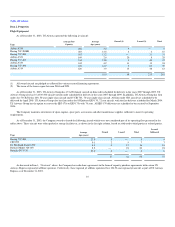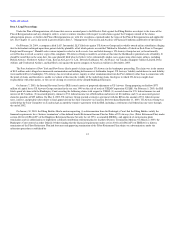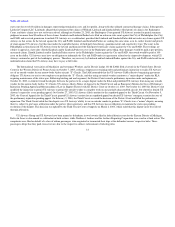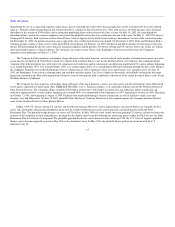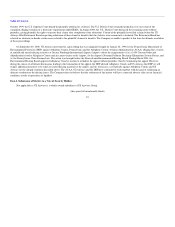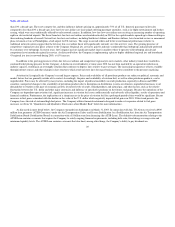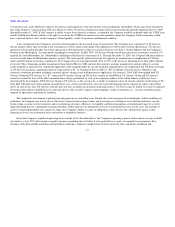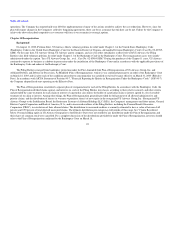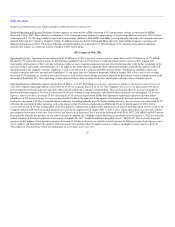US Airways 2003 Annual Report Download - page 25
Download and view the complete annual report
Please find page 25 of the 2003 US Airways annual report below. You can navigate through the pages in the report by either clicking on the pages listed below, or by using the keyword search tool below to find specific information within the annual report.
Table of Contents
than 10% a decade ago. They now compete for, and thus influence industry pricing on, approximately 75% of all U.S. domestic passenger ticket sales
compared to less than 20% a decade ago. Low-fare low-cost airlines are increasingly offering passenger amenities, such as in-flight entertainment and leather
seating, which were once traditionally offered by only network carriers. In addition, low-fare low-cost airlines are receiving an increasing number of operating
rights in slot-restricted airports. The threat from low-fare low-cost airlines accelerated noticeably in 2003 as the capital markets opened up to them resulting in
their ordering hundreds of aircraft. Several low-fare low-cost airlines, including Southwest Airlines and Frontier Airlines, have launched service or announced
plans to launch service at Philadelphia, a hub airport for US Airways. The surge in aircraft orders and better recent financial performance relative to
traditional network carriers suggest that the low-fare low-cost airline threat will significantly intensify over the next few years. The growing presence of
competitors' regional jets also poses a threat to the Company. Regional jets are faster, quieter and more comfortable than turboprops and generally preferred
by customers over turboprops. In recent years, the Company has lost significant market share in markets where it operates with turboprop aircraft and
competitors have introduced regional jet service. As discussed below, the Company is implementing a plan to deploy additional regional jets and introduced
43 regional jets into its network during 2003, a 61% increase.
In addition to the growing presence of low-fare low-cost airlines and competitors' regional jets in its markets, other industry trends have resulted in
continued ticket pricing pressure for the Company. A decline in overall industry revenue since 2001 has not been matched by an equivalent reduction in
industry capacity, resulting in an oversupply situation that continues to depress fares relative to past averages. The increasing transparency of fares available
through internet sources and other changes in fare structures which result in lower fares for many business travelers contribute to the pressure on pricing.
Aviation fuel is typically the Company's second largest expense. Prices and availability of all petroleum products are subject to political, economic and
market factors that are generally outside of its control. Accordingly, the price and availability of aviation fuel, as well as other petroleum products, can be
unpredictable. Prices may be affected by many factors, including the impact of political instability on crude production, especially in Russia and OPEC
countries; unexpected changes to the availability of petroleum products due to disruptions in distribution systems or refineries; unpredicted increases to oil
demand due to weather or the pace of economic growth; inventory levels of crude, refined products and natural gas; and other factors, such as the relative
fluctuation between the U.S. dollar and other major currencies and influence of speculative positions on the futures exchanges. Because the operations of the
Company are dependent upon aviation fuel, significant increases in aviation fuel costs could materially and adversely affect liquidity, results of operations and
financial condition. Furthermore, the implications of a sharp increase in the price of aviation fuel for a prolonged period of time would be significant. Recent
increases in fuel prices coincided with the decline in the value of the U.S. dollar which negatively impacted fuel prices in 2003. If this trend persists, the
Company faces the risk of sustained high fuel prices. The Company utilizes financial instruments designed to reduce its exposure related to fuel price
increases (see Item 7A "Quantitative and Qualitative Disclosures about Market Risk" below for more information).
As discussed in more detail below, the Company emerged from bankruptcy on March 31, 2003. In connection with this, US Airways received a $900
million loan guarantee (ATSB Guarantee) under the Air Transportation Safety and System Stabilization Act (Stabilization Act) from the Air Transportation
Stabilization Board (Stabilization Board) in connection with a $1 billion term loan financing (the ATSB Loan). The definitive documentation relating to the
ATSB Loan contains covenants that require the Company to satisfy ongoing financial requirements, including debt ratio, fixed charge coverage ratio and
minimum liquidity levels. The ATSB Loan contains covenants that also limit, among other things, the Company's ability to pay dividends on
20


